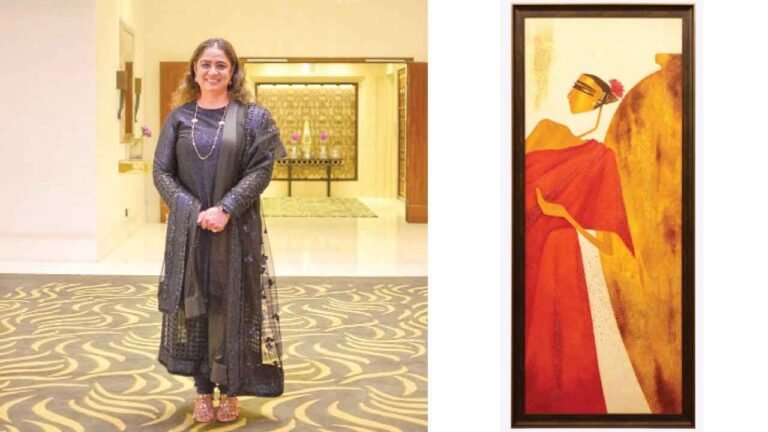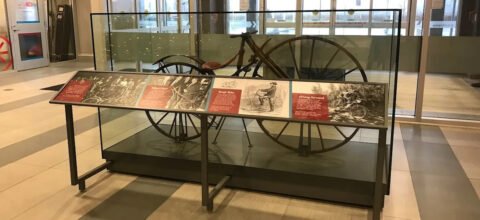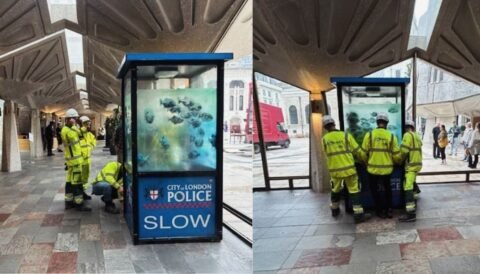Gitanjali Maini has long been a force in India’s art world — not just as the founder of Gallery G, but also as the Managing Trustee of the Raja Ravi Varma Heritage Foundation. Now, with her travelling exhibition initiative ‘On the Go’, she’s rewriting how art is accessed, experienced, and embraced across the country.
The inspiration, she shares, came from an observation. “We started noticing that many people who genuinely love art often miss major art fairs — either due to geography or timing,” she says. “That sparked the idea: what if we brought serious exhibitions to them?” With ‘On the Go,’ she is making art mobile — and meaningful. “The hope is that this motivates them to engage more deeply with the larger art world.”
Curating each edition isn’t about pitting tradition against the contemporary, she insists, but about drawing threads between them. “We curate through connection — not contrast,” she says. “A Ravi Varma might sit beside a contemporary abstraction, and both speak to storytelling in their own way. We don’t draw hard lines between eras — we seek emotional and visual resonance.”
That approach finds a natural home in Hyderabad, the latest stop for the initiative. “It’s a city where a Ganapati Hegde can sit next to a Gaitonde, who can be alongside an MF Husain — without dissonance,” Maini explains. “The city embraces both legacy and bold expression with equal warmth. We felt its collectors and viewers would truly appreciate the dialogue between the old and the new.”
Balancing such a legacy is something Maini knows intimately. As the steward of Raja Ravi Varma’s artistic heritage, she is conscious of honouring his cultural significance without letting it fossilize. “There’s rightly a deep reverence for Ravi Varma — not just because he painted gods and goddesses, but because of his discipline, dedication, and sharp contemporaneity,” she notes. “At the Foundation, we’re not only preserving the visual archive but also celebrating the values behind it — rigour, vision, and cultural intuition — qualities we also nurture in younger artists.”
This commitment to layered storytelling continues in the Hyderabad showcase, which ranges from Tanjore paintings to silver-filigree furniture. “Even in heritage furniture, there’s craftsmanship, symbolism, and layered history waiting to be rediscovered,” she explains. “That’s why we brought in a historian like Manu S. Pillai — to trace the stories behind these pieces and reframe them for a modern audience.”
Their collaboration led to a special session titled ‘Art as History,’ where Pillai explores artworks not just as visual pleasures but as living, historical narratives. “Manu’s perspective beautifully merges culture, power, and history — which aligns with how we view art objects: as living testimonies,” Maini adds.
Over the years, she has seen a distinct evolution in Indian audiences. “Earlier, art was largely transactional or aesthetic,” she observes. “Today, we see buyers wanting to understand provenance, technique, conservation, and value appreciation. The audience is sharper, younger, and often more emotionally invested — and that’s deeply encouraging.”
Through Gallery G and the Sandeep & Gitanjali Maini Foundation, she has also mentored scores of emerging artists — and what she seeks in them is not just skill, but intention. “Clarity of vision, not just technique, is what draws me,” she says. “I’m drawn to artists who know what they’re trying to say and why — those who are rooted, yet not afraid to experiment. Grit, discipline, and a willingness to grow beyond ego matter just as much as brushwork.”
Maini’s work has also connected her to an international circuit of curators, collectors, and museums — a space she believes Indian artists must actively engage with. “International visibility is no longer optional — it’s essential,” she asserts. “Indian artists are not just participants; they are redefining narratives globally. But that visibility must be strategic and sensitive — not performative. It’s about context, not just geography.”
What’s next for ‘On the Go’? Maini reveals that Coimbatore and Raipur are the next Indian cities in the lineup — and London is on the horizon. “Each city brings its own rhythm and context,” she says, “and we’re excited to adapt accordingly.”
As a woman navigating the intersections of heritage, commerce, and leadership, Maini admits the journey has had its unique challenges. “Of course. You’re often navigating rooms that weren’t built for you,” she reflects. “But instead of pushing back, I’ve focused on building my own — where integrity, collaboration, and clarity of purpose define leadership. That’s what sustains me — not just as a woman, but as a professional.”
With ‘On the Go,’ Gitanjali Maini is not just moving art across cities — she’s shifting the conversation itself. One that’s as inclusive as it is incisive, and as rooted in legacy as it is eager to write the future.





